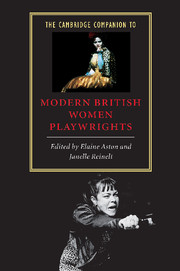Book contents
- Frontmatter
- 1 A century in view: from suffrage to the 1990s
- Part I Retrospectives
- Editors’ note
- 2 Women playwrights of the 1920s and 1930s
- 3 New plays and women’s voices in the 1950s
- 4 Women playwrights and the challenge of feminism in the 1970s
- Part II National tensions and intersections
- Part III The question of the canon
- Part IV The subject of identity
- Index
3 - New plays and women’s voices in the 1950s
from Part I - Retrospectives
Published online by Cambridge University Press: 28 May 2006
- Frontmatter
- 1 A century in view: from suffrage to the 1990s
- Part I Retrospectives
- Editors’ note
- 2 Women playwrights of the 1920s and 1930s
- 3 New plays and women’s voices in the 1950s
- 4 Women playwrights and the challenge of feminism in the 1970s
- Part II National tensions and intersections
- Part III The question of the canon
- Part IV The subject of identity
- Index
Summary
The emergence of angry young theatre
In the ten years that followed the end of the Second World War, Britain instituted a wide range of social programmes commensurate with a general pattern of economic growth and development. The decade of the 1950s brought several key events: the return of a Conservative government in 1951, the coronation in 1953 of Queen Elizabeth II (described inevitably as the dawning of a new Elizabethan Age) and, in 1956, military crisis at the Suez Canal. In brief, these key events indicate some of the important characteristics of British social life at this historical moment in that this was a time of more or less general social and ideological stability (captured in adoration of the new Queen and her own young family), undercut by specific tensions brought about by external factors (such as the dismantling of the British empire, especially when it was forced through events such as Suez) and internal factors (a new wealth and mobility for a generation of young people who had been the first beneficiaries of the 1944 Education Act offering secondary education for all). It is against this social backdrop that the theatre of the decade must be read.
Histories of twentieth-century British drama have generally pointed to 1956 as the watershed year in theatrical production after the Second World War. The reason for 1956 receiving such especial attention, of course, is the première of John Osborne’s Look Back in Anger on 8 May. The play centres on Jimmy Porter, a twenty-something lower-middle-class man, and his life with Alison, his wife, whose parents are decidedly upper-middle-class. For much of the play, Jimmy rails against everything - the classes above his own, women, culture.
- Type
- Chapter
- Information
- Publisher: Cambridge University PressPrint publication year: 2000
- 3
- Cited by

